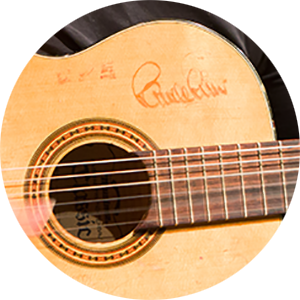
Flamenco Guitar

Guitar Lessons
The Global Music School offers guitar lessons for acoustic guitar, electric guitar, flamenco guitar and Latin-American & Brazilian guitar.
Flamenco Guitar Lessons with Peer
Peer Fritze’s lessons are structured around the following key points:
- Differentiation of the various flamenco styles and rhythms
- Characteristics of dance and vocal accompaniment
- Flamenco playing techniques
An important point in the subject of flamenco guitar is the sound of flamenco: “How do you make it sound so archaic, so powerful – so emotional…”.
The Flamenco Guitar
The flamenco guitar was traditionally dedicated to vocal accompaniment. This led to the development of flamenco techniques such as rajeos, alzapúas (thumb tapping) and golpe (tapping), and above all to certain forms of harmony, colours, flamencura and compás. The “compás” (beat) is more than rhythm or rhythmic pattern, but represents the essence of flamenco playing. The singing, and therefore the flamenco playing, has its own styles, the “palos”, with its own beats, harmonic structures and tones. The solo flamenco guitar has developed from this traditional basis. Beyond technique and repertoire, flamenco playing is a search, feeling and transmitting the “cry of the guitar” (Federico García Lorca) for every tone and every silence.
Learn more about the instrument
The flamenco guitar is actually hardly distinguishable from the concert guitar – although the choice of wood for the body plays an important role in terms of the use of the instrument. If the guitar is used for dance accompaniment, a percussive sound is desired. The flamenco guitar generally has thinner top, back and sides and is built from cypress wood. The sound is irresistibly powerful, loud and sharp, especially when played in treble. A special feature of flamenco playing is the use of a capo. By shortening the strings, the instrument can sound higher. This allows the guitar to adapt to the vocal range of singers and achieve certain timbres.
Different cultures, originally from four continents, have influenced flamenco throughout history: the people from the northwest of the Indian subcontinent who came to Europe, the Moors from North Africa who conquered most of the Iberian Peninsula, the peoples of South America who were subjugated by the Spanish, and the inhabitants of Andalusia.
The main function of the flamenco guitar is to accompany singing and dancing. Over the years, virtuosos like Paco de Lucia have developed a new style. Currently we distinguish between the traditional/classical and modern flamenco style.
Teachers
Peer Fritze
Origin of the instrument
Spain
Related Courses
Acoustic Guitar
Electric Bass
Electric Guitar
Latin-American & Brazilian Guitar
Location
Online or in Prignitz (Brandenburg)


